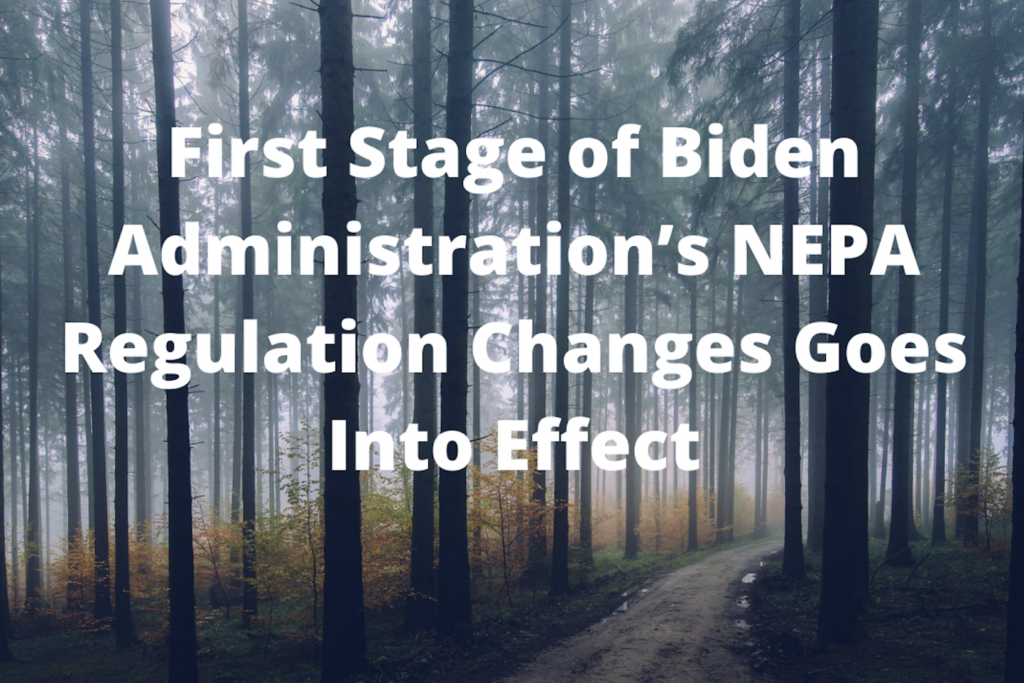Blog

First Stage of Biden Administration’s NEPA Regulation Changes Goes Into Effect
On May 20, 2022, the Council on Environmental Quality’s (CEQ’s) first round of revisions to the Trump Administration’s 2020 NEPA regulations went into effect. These new regulations (the “Phase 1 rules”) represent the first phase of the Biden Administration’s two-step review and revision of the 2020 changes to the CEQ regulations and reverse some of the principal substantive changes that the 2020 rulemaking effectuated.
As we have previously written, under the Trump Administration, CEQ made wholesale revisions to the NEPA regulations in 2020 – the first comprehensive revisions to the NEPA regulations since their issuance in 1978. The 2020 regulations introduced process-based and substantive changes to the NEPA process and established various measures designed to shorten and streamline the environmental review process.
The Biden Administration announced it would revise some of the strategic changes made to the NEPA regulations under the Trump Administration, and stated it would do so in two phases. The first phase rules, which came into effect on May 20, 2022, addressed what CEQ determined to be some of the most important fixes to the NEPA regulations. These revisions were also the most straightforward of the anticipated changes, as they reinstated three critical aspects of the NEPA regulations that had been dismantled by the 2020 regulations. According to CEQ, Phase 2 will focus on a broader set of changes.
The Phase 1 rules focus on three key issues. First, they revise the “purpose and need” requirements to ensure that agencies have flexibility to consider a variety of factors in developing purpose and need statements. The articulation of the “purpose and need” of an action is an important early step in the NEPA process that is, among other things, critical to the scope of the identification and analysis of alternatives. The 2020 regulations required agencies to base the purpose and need statement on the applicant’s goals and the agency’s authority. The 2020 regulations also defined “reasonable alternatives” as those that meet the agency’s purpose and need “and, where applicable . . . the goals of the applicant.” The Phase 1 rules restore the 1978 regulatory language and remove the reference to the goals of the applicant from the definition of “reasonable alternatives.” CEQ made these changes to ensure that agencies have flexibility in developing purpose and need statements and do not mistakenly prioritize an applicant’s goals over the agency’s policies and programs or the public interest, thereby unduly narrowing the scope of reasonable alternatives.
Second, the Phase 1 rules reinstate NEPA as the minimum review threshold for agency NEPA regulations. The 2020 regulations had added “ceiling provisions” that made the CEQ regulations the maximum requirements agencies could include in their agency-specific NEPA procedures. The Phase 1 rules delete these provisions to provide federal agencies the discretion to develop regulations that address and are attuned to their specific statutory mandates and programs, and to be more protective of the environment than the CEQ regulations require.
Finally, the Phase 1 rules revise the definition of “effects” or “impacts” to include direct, indirect, and cumulative effects. The 2020 regulations had provided a single definition for “effects” or “impacts” and deleted the subcategorization of “direct” and “indirect” effects and the definition of “cumulative impacts.” This led to some uncertainty regarding which impacts needed to be assessed. These changes had also appeared to limit the consideration of impacts such as climate change, which typically only emerge as the cumulative effect of past and proposed actions. CEQ’s changes were intended to clarify that agencies should “continue to engage in the context-specific inquiry they have undertaken for more than 40 years to identify reasonably foreseeable effects of a proposed action and its alternatives,” including the assessment of climate change impacts to which a proposal may contribute.
In adopting a phased approach, CEQ intended to strike a balance between the need to quickly address critical issues and the need to conduct a more thorough assessment of the 2020 regulations and possibly elements of the 1978 regulations that the 2020 revisions left intact. Thus, these three changes represent those issues which CEQ determined required immediate attention. However, more comprehensive changes are likely on the horizon, as CEQ is now turning its attention to Phase 2 of the revision process.